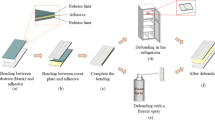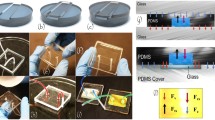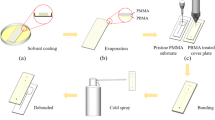Abstract
For closed-channel microfluidic chips, a layer of the cover plate is usually bonded to the substrate layer to enclose the fabricated microstructures on the surface of the substrate. Various irreversible and reversible bonding approaches have been invented for glass, thermoplastic, and PDMS-based microfluidic devices in the recent decade, including anodic bonding, thermal fusion bonding, chemical solvent assisted bonding, sandwich adhesion layer, and oxygen plasma treatment. Currently, most of the reversible bonding methods have to make compromise on bonding strength to achieve the reversible bonding between the substrate and cover plate. In this study, a novel reversible bonding method is proposed with the help of a UV curable release tape, compared with previous methods on reversible bonding using a magnetic or adhesive layer, the proposed method offers a higher bonding strength and easily debond with a simple UV exposure process. The proposed reversible bonding method using UV release tape is inspired by the application of UV release tape in the wafer dicing process in MEMS and IC industry. For the demonstration of the proposed reversible bonding method for microfluidic devices, conventional and hybrid reversible bonding between thermoplastics and glass were achieved, the bonding strength was also measured with different UV radiation doses, the biocompatibility of the UV release tape was tested, finally, several microfluidic devices were fabricated with the proposed reversible bonding method.










Similar content being viewed by others
References
Au AK, Huynh W, Horowitz LF, Folch A (2016) 3D-printed microfluidics. Angew Chem Int Ed 55(12):3862–3881
Bhattacharya S, Datta A, Berg JM, Gangopadhyay S (2005) Studies on surface wettability of poly (dimethyl) siloxane (PDMS) and glass under oxygen-plasma treatment and correlation with bond strength. J Microelectromech Syst 14(3):590–597
Bodas D, Khan-Malek C (2007) Hydrophilization and hydrophobic recovery of PDMS by oxygen plasma and chemical treatment—an SEM investigation. Sens Actuators B Chem 123(1):368–373
Chen Q, Li G, Nie Y, Yao S, Zhao J (2014) Investigation and improvement of reversible microfluidic devices based on glass–PDMS–glass sandwich configuration. Microfluid Nanofluid 16(1–2):83–90
Chu M, Nguyen T, Lee E, Morival J, Khine M (2017) Plasma free reversible and irreversible microfluidic bonding. Lab Chip 17(2):267–273
Dinh T et al (2015) Development of reversible bonding for microfluidic applications. Microfluidics Nanofluidics 19(3):751–756
Fan Y, Li H, Yi Y, Foulds IG (2014) PMMA to Polystyrene bonding for polymer based microfluidic systems. Microsyst Technol 20(1):59–64
Funano S-I, Ota N, Tanaka Y (2021) A simple and reversible glass–glass bonding method to construct a microfluidic device and its application for cell recovery. Lab Chip 21(11):2244–2254
Gong X et al (2010) Wax-bonding 3D microfluidic chips. Lab Chip 10(19):2622–2627
Gu P, Liu K, Chen H, Nishida T, Fan ZH (2011) Chemical-assisted bonding of thermoplastics/elastomer for fabricating microfluidic valves. Anal Chem 83(1):446–452
Kojic SP, Stojanovic GM, Radonic V (2019) Novel cost-effective microfluidic chip based on hybrid fabrication and its comprehensive characterization. Sens Actuators A 19(7):1719
Kurihara K, Hokari R, Satoh T, Sugiura S, Miyake K, Kanamori T (2020) Low-deformation precision thermal bonding of nanostructured microfluidic chips. Jpn J Appl Phys 59(1):8
Le Berre M, Crozatier C, Velve Casquillas G, Chen Y (2006) Reversible assembling of microfluidic devices by aspiration. Microelectron Eng 83(4):1284–1287. https://doi.org/10.1016/j.mee.2006.01.257
Le NXT, Lee NY (2020) Chitosan–polydopamine hydrogel complex: a novel green adhesion agent for reversibly bonding thermoplastic microdevice and its application for cell-friendly microfluidic 3D cell culture. Lab Chip 20(19):3524–3534
Liu S, Fan Y, Gao K, Zhang Y (2018) Fabrication of Cyclo-olefin polymer-based microfluidic devices using CO2 laser ablation. Mater Res Express 5(9):095305
Lynh HD, Pin-Chuan C (2018) Novel solvent bonding method for creation of a three-dimensional, non-planar, hybrid PLA/PMMA microfluidic chip. Sens Actuators A Phys 280:350–358
Mahmoodi S, Sun P-K, Mayer M, Besser R (2019) Gas-assisted thermal bonding of thermoplastics for the fabrication of microfluidic devices. Microsyst Technol 25(10):3923–3932
Meng Q, Zhang Y, Li J, Lammertink RG, Chen H, Tsai PA (2016) Altering emulsion stability with heterogeneous surface wettability. Sci Rep 6(1):1–8
Moon B-U, Morton K, Li K, Miville-Godin C, Veres T (2021) Reversible Bonding of Thermoplastic Elastomers for Cell Patterning Applications. Processes 9(1):54
Nath P, Fung D, Kunde YA, Zeytun A, Branch B, Goddard G (2010) Rapid prototyping of robust and versatile microfluidic components using adhesive transfer tapes. Lab Chip 10(17):2286–2291
Pitingolo G, Nizard P, Riaud A, Taly V (2018) Beyond the on/off chip trade-off: A reversibly sealed microfluidic platform for 3D tumor microtissue analysis. Sens Actuators B Chem 274:393–401
Pitingolo G, Riaud A, Nastruzzi C, Taly V (2019a) Gelatin-coated microfluidic channels for 3d microtissue formation: On-chip production and characterization. Micromachines 10(4):265
Pitingolo G, Riaud A, Nastruzzi C, Taly V (2019b) Tunable and reversible gelatin-based bonding for microfluidic cell culture. Adv Eng Mater 21(8):1900145
Rasponi M, Piraino F, Sadr N, Lagana M, Redaelli A, Moretti M (2011) Reliable magnetic reversible assembly of complex microfluidic devices: fabrication, characterization, and biological validation. Microfluidics Nanofluidics 10(5):1097–1107
Ren Y, Ray S, Liu Y (2019) Reconfigurable acrylic-tape hybrid microfluidics. Sci Rep 9(1):1–10
Sackmann EK, Fulton AL, Beebe DJ (2014) The present and future role of microfluidics in biomedical research. Nature 507(7491):181–189
Serra M, Pereiro I, Yamada A, Viovy J-L, Descroix S, Ferraro D (2017) A simple and low-cost chip bonding solution for high pressure, high temperature and biological applications. Lab Chip 17(4):629–634
Shang L, Cheng Y, Zhao Y (2017) Emerging droplet microfluidics. Chem Rev 117(12):7964–8040
Shiroma LS et al (2016) Self-regenerating and hybrid irreversible/reversible PDMS microfluidic devices. Sci Rep 6(1):1–12
Sivakumar R, Lee NY (2020) Heat and pressure-resistant room temperature irreversible sealing of hybrid PDMS–thermoplastic microfluidic devices via carbon–nitrogen covalent bonding and its application in a continuous-flow polymerase chain reaction. RSC Adv 10(28):16502–16509
Song K-Y, Zhang H, Zhang W-J, Teixeira A (2018) Enhancement of the surface free energy of PDMS for reversible and leakage-free bonding of PDMS–PS microfluidic cell-culture systems. Microfluid Nanofluid 22(11):1–9
Tran HH, Wu W, Lee NY (2013) Ethanol and UV-assisted instantaneous bonding of PMMA assemblies and tuning in bonding reversibility. Sens Actuators B Chem 181:955–962
Tsao C-W, Syu W-C (2020) Bonding of thermoplastic microfluidics by using dry adhesive tape. RSC Adv 10(51):30289–30296
Vézy C, Haddour N, Dempsey N, Dumas-Bouchiat F, Frénéa-Robin M (2011) Simple method for reversible bonding of a polydimethylsiloxane microchannel to a variety of substrates. Micro Nano Lett 6(10):871–873
Vulto P et al (2005) Microfluidic channel fabrication in dry film resist for production and prototyping of hybrid chips. Lab Chip 5(2):158–162
Wasay A, Sameoto D (2015) Gecko gaskets for self-sealing and high-strength reversible bonding of microfluidics. Lab Chip 15(13):2749–2753
Zhang Y, Liu J, Wang H, Fan Y (2019) Laser-induced selective wax reflow for paper-based microfluidics. RSC Adv 9(20):11460–11464
Acknowledgements
This work was supported by the National Natural Science Foundation of China (No. 51804014).
Author information
Authors and Affiliations
Corresponding author
Additional information
Publisher's Note
Springer Nature remains neutral with regard to jurisdictional claims in published maps and institutional affiliations.
Rights and permissions
About this article
Cite this article
Yao, Y., Li, L., Jiang, J. et al. Reversible bonding for microfluidic devices with UV release tape. Microfluid Nanofluid 26, 23 (2022). https://doi.org/10.1007/s10404-022-02532-4
Received:
Accepted:
Published:
DOI: https://doi.org/10.1007/s10404-022-02532-4




